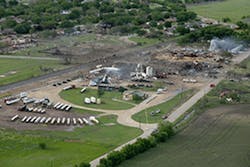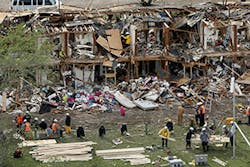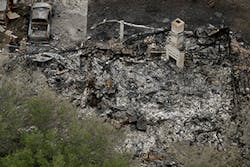"Dangerously Close:" CSB Examines the Fatal Explosion in West, Texas
The U.S. Chemical Safety Board (CSB) on Jan. 29 released a safety video that explores the fatal April 17, 2013, fire and explosion at the West Fertilizer Co. in West, Texas, which resulted in 15 fatalities, more than 260 injuries and widespread community damage. The deadly fire and explosion occurred when approximately 30 tons of fertilizer grade ammonium nitrate (FGAN) exploded after a fire at the storage and distribution facility caused it to heat up.
The 12-minute safety video, “Dangerously Close: Explosion in West, Texas,” includes a 3D animation of the fire and explosion as well as interviews with CSB investigators and Chairperson Vanessa Allen Sutherland. The video can be viewed on the CSB’s web site and on YouTube.
“This tragic accident should not have happened,” said Sutherland. “We hope that… sharing lessons learned from our West Fertilizer Co. investigation will help raise awareness of the hazards of fertilizer grade ammonium nitrate so that a similar accident can be avoided in the future.”
The CSB’s investigation found that several factors contributed to the severity of the explosion, including poor hazard awareness and the fact that nearby homes and business were built in close proximity to the West Fertilizer Co. over the years prior to the accident. The video explains that there was a stockpile of 40 to 60 tons of ammonium nitrate stored at the facility in plywood bins on the night of the explosion. And although FGAN is stable under normal conditions, it violently can detonate when exposed to contaminants in a fire.
In the video, Team Lead Johnnie Banks says, “We found that as the city of West crept closer and closer to the facility, the surrounding community was not made aware of the serious explosion hazard in their midst. And the West Fertilizer Co. underestimated the danger of storing fertilizer grade ammonium nitrate in ordinary combustible structures.”
The CSB investigation concludes that this lack of awareness was due to several factors, including gaps in federal regulatory coverage of ammonium nitrate storage facilities. The video details safety recommendations made to OSHA and the EPA to strengthen their regulations to protect the public from hazards posed by FGAN.
Finally, the video explains how inadequate emergency planning contributed to the tragic accident. The CSB found that the West Volunteer Fire Department was not required to perform pre-incident planning for an ammonium nitrate-related emergency, nor were the volunteer firefighters required to attend training on responding to fires involving hazardous chemicals. As a result, the CSB made several safety recommendations to various stakeholders, including the EPA, to better inform and train emergency responders on the hazards of FGAN and other hazardous chemicals.
“The CSB’s goal is to ensure that no one else be killed or injured due to a lack of awareness of hazardous chemicals in their communities,” said Sutherland. “If adopted, the board’s recommendations can help prevent disasters like the one in West, Texas.”
About the Author

Sandy Smith
Sandy Smith is the former content director of EHS Today, and is currently the EHSQ content & community lead at Intelex Technologies Inc. She has written about occupational safety and health and environmental issues since 1990.


